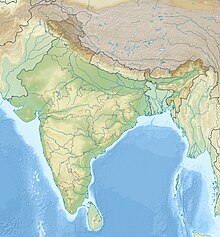Mahakali Caves
| Kondivite Caves | |
|---|---|
 Kondivite Caves, Cave 2. | |
| Location | Andheri (East), Near Caves road, Mumbai |
| Coordinates | 19°07′50″N 72°52′27″E / 19.130436°N 72.874133°E |
| Elevation | 70 m (230 ft) |
| Geology | Basalt |
| Entrances | 20 |
| Difficulty | easy |
| Pilgrimage to |
| Buddha's Holy Sites |
|---|
 |
The Mahakali Caves, also Kondivite Caves, are a group of 19 rock-cut monuments built between 1st century BCE and 6th century CE.[1]
This Buddhist monastery is located in the eastern suburb of Andheri in the city of Mumbai (Bombay) in western India. Monument consists of two groups of rock-cut caves - 4 caves more to the north-west and 15 caves more to the south-east. Most caves are viharas and cells for monks, but Cave 9 of south-eastern group is chaitya. Caves in north-west have been created mainly in 4th - 5th century, while south-eastern group is older. Monument contains also rock-cut cisterns and remnants of other structures.
Caves are carved out of a solid black basalt rock,(volcanic trap breccias, prone to weathering).
The largest cave at Kondivite (Cave 9) has seven depictions of the Buddha and figures from Buddhist mythology but all are mutilated.[2]
It is located near the junction between the Jogeshwari-Vikhroli Link Road and SEEPZ. The road that connects these monuments to Andheri Kurla Road is named Mahakali Caves Road after it. The caves are located on a hill that overlooks the Jogeshwari-Vikhroli Link Road and the SEEPZ++ area.[3] A Direct bus run by the BEST links the caves with Andheri station. The caves was in danger of being encroached upon, now it is steel fenced on the road side and walled on the hill side.[clarification needed]
-
Kondivite Caves
-
Buddha Stupa in Cave 9.
-
Volume plan of Cave 9.
See also
References
- ^ Jaisinghani, Bella (13 July 2009). "Ancient caves battle neglect". Times of India. Retrieved 28 October 2009.
- ^ Bavadam, Lyla (18–31 July 2009). "In a shambles". Frontline. Archived from the original on 25 January 2013. Retrieved 28 October 2009.
- ^ Gaur, Abhilash (25 January 2004). "Pay dirt: Treasure amidst Mumbai's trash". The Tribune. Retrieved 1 September 2008.
External links
![]() Media related to Mahakali Caves at Wikimedia Commons
Media related to Mahakali Caves at Wikimedia Commons





